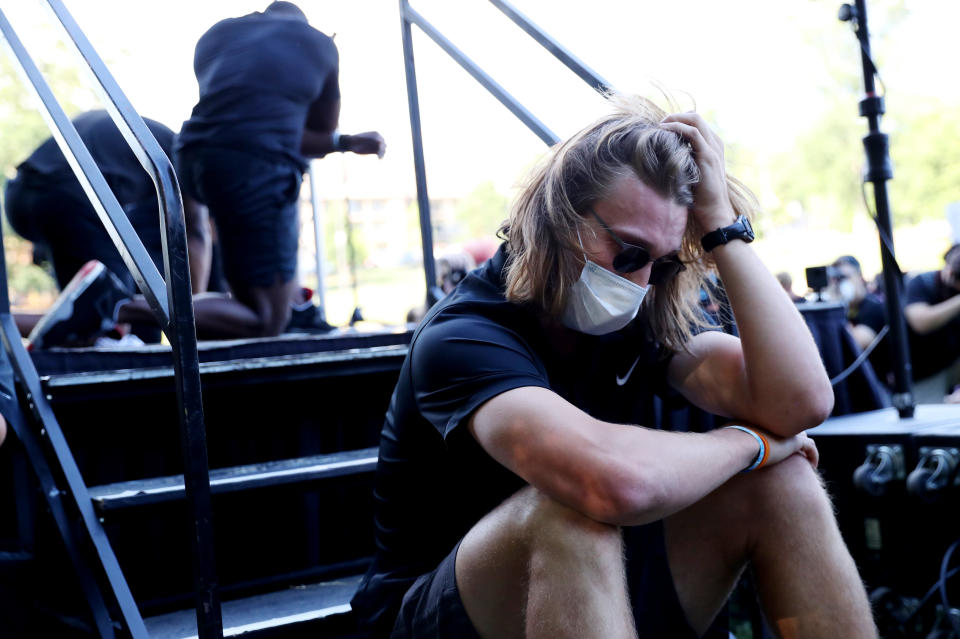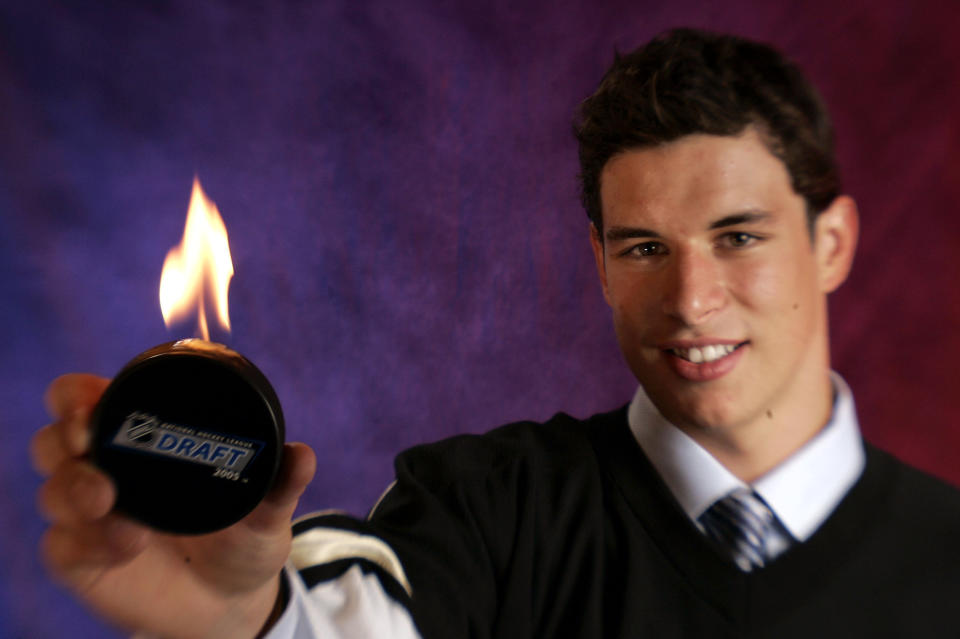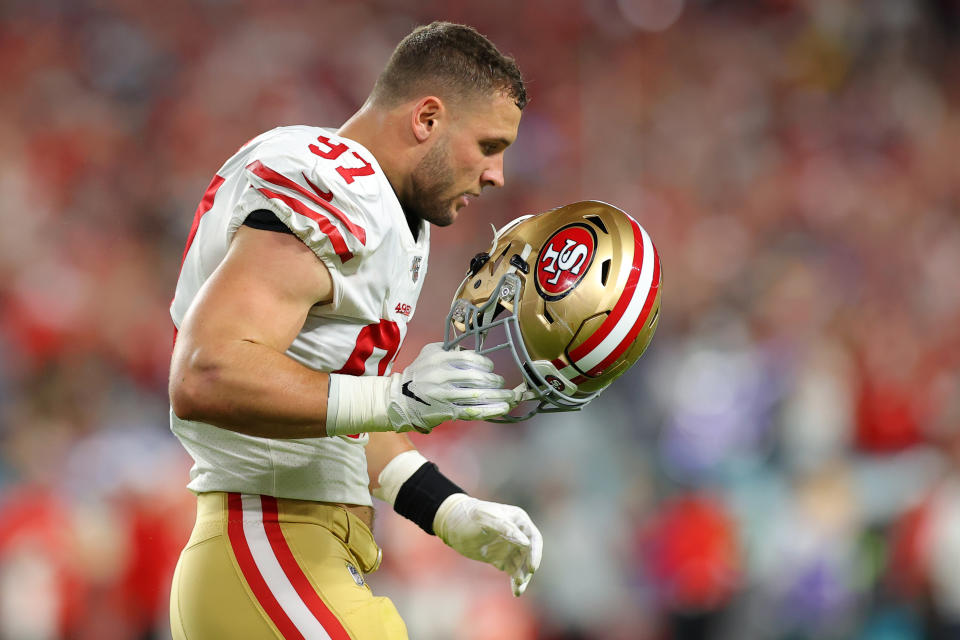What happens to 2021 draft order if NFL season is cancelled? Here are 3 possible scenarios
The confidence in an NFL season occurring — at least in part — in 2020 feels higher right now than it does for a college football season this fall. But there’s no iron-clad belief the pros will go on without issues amid the COVID-19 pandemic.
If there’s one thing we’ve learned throughout this ordeal it’s that there’s never enough time to plan ahead. That’s why we’re kicking around the idea of what could happen to the 2021 NFL draft if, worst-case scenario, there’s no 2020 season. (We promise we’re not trying to be fatalistic here — merely practical, prudent and proactive.)
So far, the league is mum on the matter. We called around to various team and league sources, and there isn’t much buzz on the matter.
Even so, here are three scenarios we could see unfolding. None are perfect, but the NFL would have to weigh these options (or others) to generate the best outcome out of the worst result.
Keep the 2020 draft order for 2021
This would be, quite frankly, a problematic result. The NFL isn’t like other leagues where teams stay bad (or good) for long stretches as readily.
NFL teams that earned top-five selections from 2015 to 2019 — whether they traded the pick or not — gained a net average of 3.64 victories (with ties counted as half a win), which resulted in an average improvement of .228 in win percentage that ensuing season.
Of the 25 teams that originally held top-five picks in that span, including those that traded their first-round selections previously (such as the Rams in the Jared Goff deal or the Texans in the Deshaun Watson trade), only three saw their win totals decrease the following year.
Little shock: The Browns accomplished that twice. In that span, the Browns were also the only team to pick again in the top five the following year, landing there in 2016, 2017 and 2018. The point is that bad teams one year roundly tend to get better the next.
If we kept the 2020 order static, that would mean the Cincinnati Bengals would pick first again in 2021, followed by Washington, the Lions, Giants and Dolphins. There’s no way the Bengals would select the presumed 2021 top-pick favorite, Clemson QB Trevor Lawrence, having taken LSU’s Joe Burrow this spring, right?

Even if the Bengals viewed Lawrence as a better prospect than Burrow, it would create some real awkwardness if they moved on so quickly from a QB prospect — and the local kid, no less — before he even suited up for them. On top of that, the trade value for Lawrence, who turns 21 in October, almost certainly would be higher than that of Burrow, who turns 24 in December.
That means the Bengals could gain a huge advantage by putting the No. 1 pick up for sale. In addition to the extra picks they’d get, the Bengals might even be in position to land offensive tackle help (such as Oregon’s Penei Sewell) or give Burrow his go-to college receiver (LSU’s Ja’Marr Chase) if they can remain high enough in the draft in a trade-down situation.
Two teams — the Rams and Texans — don’t own their 2021 first-round picks because of trades. That means the Jaguars would, under this scenario, own the ninth (their own) and 20th overall picks (from the Rams) for the second straight year. The Dolphins once again would head into the 2021 draft with the fifth (their own) and 26th overall picks (from the Texans).
And like the Bengals, the Dolphins — who just drafted Tua Tagovailoa — also could put their pick up for bid if the right quarterback prospect, such as Ohio State’s Justin Fields or North Dakota State’s Trey Lance, were appealing options for other teams.
Keeping the 2020 order for 2021 would represent the path of least resistance. That doesn’t mean it would be the most popular option. Very rarely does the top of the draft look the same, one year to the next.
Follow the 2005 NHL draft model
Back in 2004, the NHL and its players union were locked in a labor dispute, and the ensuing season was canceled. After delaying the draft nearly a month, the league determined its 2005 draft order based on a weighted lottery system.
Under those stipulations, the teams that had missed the playoffs each of the previous three seasons and those that had not earned the top overall selection the prior four years were given the most lottery balls (three). Six of the NHL’s 30 clubs met both criteria.
Ten NHL teams that had one playoff appearance or the first overall pick in those years each earned two lottery balls. And the remaining 16 clubs that met neither criteria each were given one ball.
The NHL’s lottery process that year was different than the NBA’s system in that all 30 teams had a shot at the top pick. The odds were also far greater in the NHL’s system for a good team landing the top pick — could you imagine the Detroit Red Wings having landed the first overall pick (a generational talent in Sidney Crosby) after averaging a league-best 111.5 points the previous four seasons?
If the NFL adopted this format, there would be a chance for a team such as the Patriots earning the top pick in 2021, which surely would go over well. Your “Bill Belichick tanking for Trevor” tweets wouldn’t look as absurd now, that’s for sure.

The NHL produced some wild results that year. The four teams with three lottery balls (Pittsburgh Penguins, Columbus Blue Jackets, Buffalo Sabres and New York Rangers) earned first, sixth, 13th and 16th picks, respectively.
Meanwhile, five of the 16 one-ball lottery teams ended up picking higher than expected. The big winners were the Montreal Canadiens, who ended up with the fifth overall pick after winning a playoff series in the 2003-04 season. The San Jose Sharks, who won 10 playoff games and made it to the conference finals, picked 12th.
Two other playoff teams, the Ottawa Senators and Vancouver Canucks, picked ninth and 10th, respectively. The Red Wings, the regular-season points leaders, picked 19th — ahead of two non-playoff teams, the Edmonton Oilers and Florida Panthers, who picked 25th and 29th, respectively.
If the NFL tried this format, it might have to drastically alter the system.
Using the NHL’s model, the three-ball lottery teams would be the Tampa Bay Buccaneers, New York Jets, Denver Broncos and Washington. The two-ball teams: the Browns, Arizona Cardinals, Cincinnati Bengals, San Francisco 49ers, Chicago Bears, Los Angeles Chargers, Indianapolis Colts, Carolina Panthers, Jacksonville Jaguars, New York Giants, Detroit Lions, Las Vegas Raiders and Miami Dolphins. The remaining 15 teams would receive one lottery ball.
That would create a 53-ball lottery where the three-ball teams would each have a 5.7 percent chance of the top pick; the two-ball teams would have a 3.8 percent chance; and each of the one-ball teams would have a 1.9 percent chance.
Just for fun, we ran 10 simulations using these rules. Here are how the top-10 picks came out for those (any repeat team picks were just rerolled, using Google’s random generator):

* — pick belongs to Jaguars
** — pick belongs to the Dolphins
We swear we did this fairly. But you might want to get your cringe face ready when you see Simulation 6, which almost looks like a playoff field and could result that dreaded Lawrence-to-Foxborough scenario.
Imagine the high-wire act that is being a Jets fan. In these 10 scenarios, they either pick really high (No. 1 pick three times and No. 2 overall once) or get left out of the top 10 entirely (four times) with equal frequency. Take a guess what that fan base assumes would happen on the real draw.
Some of the simulations look fairly close to like one would expect. But it feels as if the weighted system would need to reward more consistently underachieving teams.
NHL commissioner Gary Bettman understood that few people would be happy with how that league ran its lottery under tough circumstances.
“Half the league probably wanted everybody to have an equal chance, and the other half wanted all the teams that didn’t make the playoffs to have the only chances, weighted or unweighted,” Bettman said. “And if you look at the statistical odds of both scenarios, what we did is about in the middle. And so actually nobody was particularly thrilled, but everybody understood that on balance it was probably the fairest way to approach it.”
If a good team ends up with the No. 1 pick, especially in a year when Lawrence is such a household name, the laity assumption will be that the draft was rigged. But the NFL also knows that a lottery event would be made-for-TV gold for the league to showcase and help recoup a sliver of the lost revenue from a missed season.
There are problems with this method, but there’s also a potential solution from within it.
Stick straight to the recent numbers
This is a suggestion we’re lifting from a smart Reddit user, “jeckenimbo,” who suggested merely averaging out the past three seasons’ results and running the order inverse of winning percentage. And the first tiebreaker here would be 2019 victories.
That would give us a draft order of:
1. Giants 2. Browns 3. Bengals 4. Jets 5. Cardinals 6. Washington 7. Raiders 8. Buccaneers 9. Dolphins 10. Broncos 11. Lions 12. Jaguars 13. Colts 14. Panthers 15. 49ers 16. Falcons 17. Bears 18. Bills 19. Texans (traded to Dolphins) 20. Chargers 21. Packers 22. Cowboys 23. Titans 24. Seahawks 25. Steelers 26. Eagles 27. Vikings 28. Rams (traded to Jaguars) 29. Ravens 30. Chiefs 31. Patriots 32. Saints
Not bad. Of course, that also treats 2017 results nearly as equally as 2019 victories, so a system that is more heavily weighted toward recency could be implemented.
Here, for instance, is a model another Reddit user suggested that uses a 10-30-60 weighted split for 2017, 2018 and 2019 records, respectively, along with the same 2019-victory tiebreaker:
1. Bengals 2. Giants 3. Lions 4. Washington 5. Cardinals 6. Dolphins 7. Browns 8. Jets 9. Raiders 10. Jaguars 11. Panthers 12. Buccaneers 13. Broncos 14. Falcons 15. Chargers 16. Colts 17. Cowboys 18. Bills 19. Steelers 20. Bears 21. Titans 22. Eagles 23. 49ers 24. Vikings 25. Texans (traded to Dolphins) 26. Packers 27. Rams (traded to Jaguars) 28. Seahawks 29. Patriots 30. Chiefs 31. Ravens 32. Saints
This model clearly boosts teams such as the Lions and Steelers and hurts teams such as the Browns and 49ers. But overall, this method would upset the fewest people, as it’s generally a solid representation of how the teams might stack up, outside of a few expected leaps and falls we get every season.
A similar suggestion from our friend, Pete Fiutak of Collegefootballnews.com, looks not at the standings but rather draft order itself.
It’s a subtle but significant distinction. After all, you can win four games in a season and pick second overall, as the 49ers did (landing Nick Bosa) in 2019. Or you can win four games and pick seventh overall, as the 49ers did in 2016.

Likewise, you can win seven games, make the playoffs and pick 20th or later, per draft rules, as the 2014 Panthers did, landing the 25th pick. Or a team can win seven games, like the Jets did last year, and pick 11th overall. The 2011 Giants went 9-7 but won the Super Bowl that year, and thus picked 32nd. The 2017 Ravens went 9-7, missed the playoffs and earned the 16th pick.
This system more accurately reflects the draft-slot benefit over the standings. Pete’s model averages out the first-round draft positions (before picks were traded) for every team over the past three years. That gives us a potential 2021 order of:
1. Browns 2. Bengals 3. Jets 4. Giants T5. Bears T5. Chargers 7. Colts 8. Washington 9. Cardinals 10. Dolphins 11. Panthers T12. Broncos T12. Buccaneers T14. Jaguars T14. 49ers 16. Lions 17. Raiders 18. Rams (traded to Jaguars) 19. Bills 20. Texans (traded to Dolphins) 21. Ravens 22. Saints 23. Cowboys 24. Eagles 25. Vikings 26. Seahawks 27. Titans T28. Falcons T28. Packers 30. Steelers 31. Chiefs 32. Patriots
Don’t forget that the 2021 NFL draft is scheduled to be held in Cleveland. We’re not saying the league would rig it to benefit the locals, but the fans there wouldn’t be too angry.
But where Pete’s system goes next level — and perhaps a wee bit beyond where the league might be willing to go — is that he suggests reversing the order every round. You know, a “snake” draft, like the method thousands of you employ in standard fantasy football leagues.
Would fantasy really meet reality? We suspect not, even though teams such as the Patriots, who seem to annually hoard second-rounders, would be in favor of this.
No system is perfect, clearly, and the hope is that by the time the 2021 NFL draft rolls around, we will have played a full (or mostly full) season and that all of this is moot. Perhaps the solution lies somewhere in the middle of the final two suggestions, using a weighted lottery system but one that is based more on rolling winning percentages or draft slots, or some combination of the two.
And it never helps to get a head start on this sort of thing. Advanced planning never hurt anyone, especially not a professional sports league.
More from Yahoo Sports:

 Yahoo Sports
Yahoo Sports 
